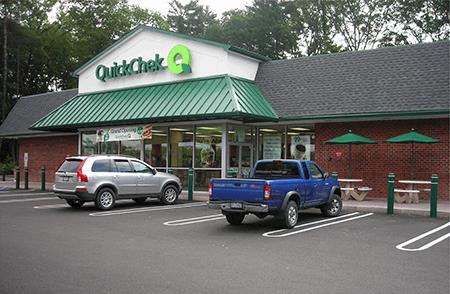Tech That Keeps Associates In Check
By Matt Pillar, chief editor
Convenience chain QuickChek gained huge store-level efficiencies by replacing manual legacy systems with a progressive suite of workforce management applications.
It’s not at all uncommon for large dairy operations to launch regional convenience store chains. That’s how Quick-Chek got its start. Building on a legacy of dairy production dating back to 1888, Carlton C. Durling of Durling Farms fame opened the first QuickChek in Dunellen, NJ, in 1967. Today, the company employs more than 4,000 Team Members and operates more than 140 stores throughout New Jersey and New York. It’s expanded its assortment to include fresh food, coffee, convenience store sundries, and fuel in addition to fresh dairy products.
 For a regional chain, QuickChek is well-recognized on a national scale for its success. Convenience Store Decisions named it 2016 Convenience Store Chain of the Year. The company earned a Hot Beverage Innovator award from Convenience Store News in 2014, and in 2016 the same publication named Maria Fidelibus, QuickChek’s VP of IT, Technology Leader of the Year.
For a regional chain, QuickChek is well-recognized on a national scale for its success. Convenience Store Decisions named it 2016 Convenience Store Chain of the Year. The company earned a Hot Beverage Innovator award from Convenience Store News in 2014, and in 2016 the same publication named Maria Fidelibus, QuickChek’s VP of IT, Technology Leader of the Year.
One of the awards that the company most relishes, how ever, is the 2016 “Best Places To Work” designation it earned from the weekly business journal NJBIZ. QuickChek prides itself on a commitment to its Team Members, and it backs that commitment up with employee-facing technology investments.
A History Of WFM Investment
Amy DaSilva, communications and systems specialist at QuickChek, has been with the company since 2003. No one’s better suited to speak to the company’s commitment to its Team Members than she is. DaSilva started her career with the company as a store Team Member during her college years. In 2009, she joined the corporate IT department. Shortly thereafter, DaSilva joined a team of QuickChek Team Members responsible for implementing a comprehensive set of workforce management tools. That project began with a Reflexis labor scheduling and time and attendance implementation in 2010.
“We had been using Team Member Social Security numbers for punching in, but we ran into risks with that,” says DaSilva. “We had a basic PC clock in the back office where they would punch in their number. If they shared that number, anyone could punch them in.”
It also wasn’t a secure environment given the use and likelihood of sharing personally identifiable information.
Amy DaSilva, communications and systems specialist, QuickChek
As for its scheduling system, DaSilva says weekly schedules were written on paper from scratch, a time-consuming effort that took place without relation to punches or historical time clock data. “We installed biometric time clocks from Control Module in each location and married them with Reflexis time and attendance and labor scheduling,” says DaSilva. “Punch data pairs directly up with schedule, and leaders are given real-time, actionable data.” Electronic schedule templates reduce store hours, and electronic communication of those schedules reduces the number of phone calls leaders field regarding Team Member schedules. “Before, when we had scheduling or attendance anomalies, leaders might not have seen it until the end of the week. Now, they can address it the day it happens.”
In 2012, the Reflexis project continued with the addition of the StoreWalk task management module. “When it came to our internal and external audits, we were simply generating too many emails for Store Leaders to review,” says DaSilva. “We could not monitor our retention rate or possibly know how many emails and directives were getting deleted.” QuickChek also lacked the ability to automatically assign best practice corrective action in response to noncompliance, and track that corrective action to completion.
“We had no central source of information on the tasks being given to stores, whether stores were completing them, whether completion was on time, and how long it took,” says DaSilva. “Auditors would print an audit, walk the store, take paper notes, then go home and enter the audit on the computer and email it to someone else.” That, she says, was too time-consuming and resulted in no immediate action being taken because communication wasn’t happening in real time. “Audit results were emailed or stored in multiple locations so there was no easy way to compare and review them.”
With four years of the task management system under its belt, DaSilva says the company has gained considerable efficiencies. “Now, auditors use iPads to complete an audit in real time and get the report sent to whoever is assigned to receive it.” She says the efficiency gains are obvious and felt, and that the store audit solution helps ensure food service safety standards are met and loss prevention and safety policies are followed.
Real-Time Data Drives Results
In 2015 and 2016, DaSilva oversaw upgrades of Task Manager, StoreWalk, Workforce Manager, and Time and Attendance. “Our store teams can now spend more time with customers and vendors. Our workforce management applications have unified our auditing system, tamed the chaos of multiple emails, redundancy, and inconsistent communications,” she says.
Across the suite of WFM solutions, DaSilva says real-time data access is the common thread of the efficiency gains QuikChek has achieved. “Each module gives us data that we can react to immediately. Before, it just took too long to generate actionable results from our data.” Now, she says the business is challenged to keep up with the changing technology that Team Members use to send and receive information. “We’re intent on staying ahead of the communication preferences of our Team Members so we’re implementing a mobile app that will allow them to view their schedules, request time off , and swap shifts from their mobile phones,” says DaSilva.
